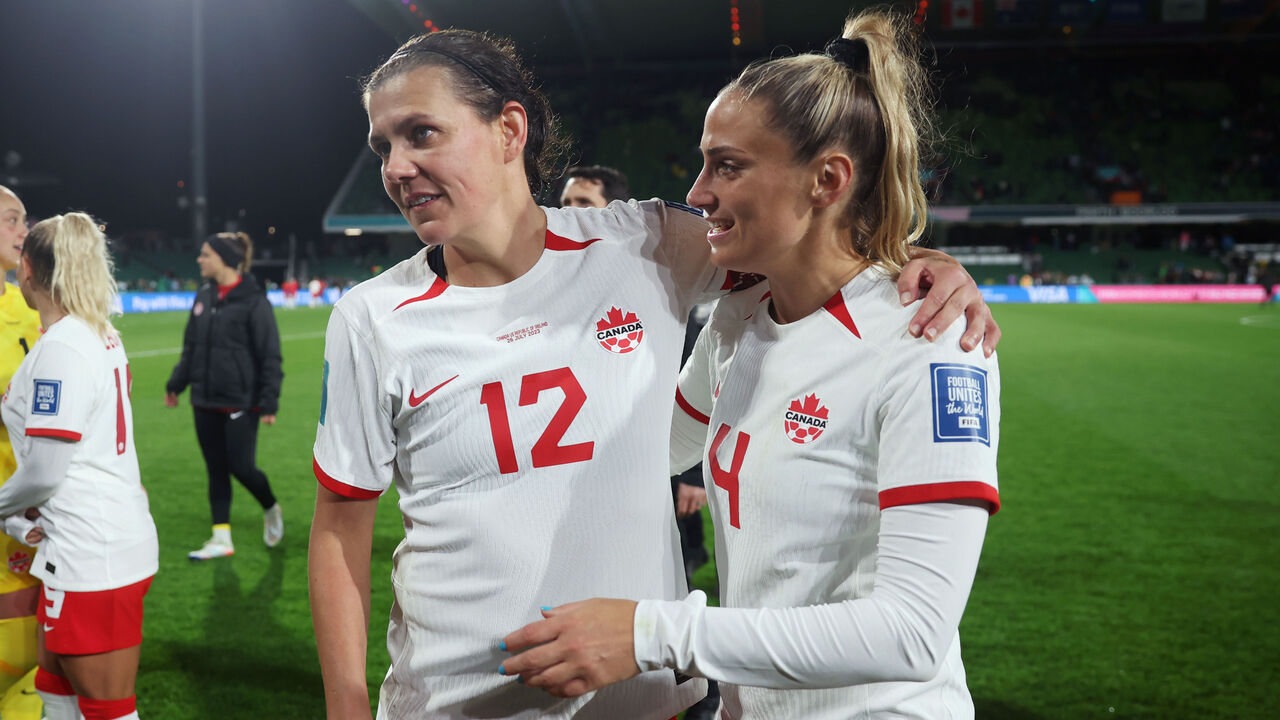4 key takeaways from Canada's World Cup-saving win over Ireland
With the help of head coach Bev Priestman's much-needed substitutions, Canada salvaged its hopes of winning the Women's World Cup with a pivotal comeback victory Wednesday over the Republic of Ireland. Here are four key takeaways from a result that could transform Canada's tournament.
Schmidt takes control in midfield
Before Sophie Schmidt restored order in midfield, Canada played some of the messiest soccer you'll see all tournament. Speculative long balls and pot shots from distance were all the team could muster. Not even Canada's stoppage-time equalizer - an own goal off Megan Connolly's clearance attempt - could leave anyone feeling confident about Canada's game as the teams broke for halftime.
Enter Schmidt. The halftime substitution looked peculiar on the surface, with Julia Grosso, Canada's only positive performer in the opening period, ultimately sacrificed. But it allowed Schmidt to take on the responsibility she needed to swing the game in her country's favor. The 35-year-old veteran sent teammates into dangerous areas with defense-splitting, on-the-ground passes that were largely absent in the first half and set up Adriana Leon's winning goal.
Schmidt's play also had a calming effect on Jessie Fleming and Quinn. The two midfielders struggled to read the game in the first half, but they looked more composed in possession with Schmidt by their side. Their passes hit the target frequently, and the quality of Canada's buildup play improved dramatically. If Ireland's early goal - a fourth-minute dagger straight from a corner kick - had disrupted Canada's flow, Schmidt helped the team find its rhythm again.
Sinclair effective with or without goals
Christine Sinclair began a Women's World Cup match on the bench Wednesday for the first time since 1999. The decision had its merits: Sinclair missed a penalty in Canada's opening match against Nigeria, and she hasn't scored internationally in more than a year. But it still felt weird. Even at 40, Sinclair affects the way Canada plays, even if international soccer's most prolific scorer doesn't convert with devastating efficiency anymore.
Now in her sixth World Cup, Sinclair is having to evolve. While her teammates do the job she used to do - Leon, Cloe Lacasse, Jordyn Huitema, and Evelyne Viens all have scoring prowess - Sinclair takes up deeper positions to create the very chances she used to tap home. Her linkup play is critical, and her willingness to track back and connect with teammates encourages them to play shorter, sharper passes.

That's not to say Sinclair has turned into a midfielder. She still attacks the penalty area and had two great chances to extend Canada's lead over Ireland. But she knows how to get involved, with or without service. Viens, who started Wednesday ahead of Sinclair, struggled without it, finishing with just 11 touches in the first half, fewer than any other Canadian, including goalkeeper Kailen Sheridan. Sinclair, on the other hand, produced 32 touches and two key passes en route to victory.
Lacasse a huge threat off the bench
One of Priestman's most difficult decisions at the Women's World Cup has been whether to start Lacasse, an explosive forward coming off a career year with Benfica and a high-profile move to Arsenal. Lacasse hit the back of the net 27 times for the Portuguese club, and while she entered the tournament with just a single international goal to her name, head coach Priestman predicted she'd play a "pivotal" role.
Though it's not the role many expected Lacasse to play, she's made a discernable impact as a substitute. She dominated Wednesday with limited minutes, challenging Ireland's defenders to footraces and winning almost all of them. A center-forward by trade, Lacasse looked comfortable on right wing, completing two of the three dribbles she attempted. Free of center-backs shadowing her every move, Lacasse had space to showcase her direct style of play, and the Irish had no answer for it.
If Leon builds on her strong performance Wednesday, it's unlikely Lacasse will get an opportunity to start in Australia and New Zealand. But that's not necessarily a bad thing for Canada. As a second-half substitute with fresh legs, the 29-year-old can stretch tiring defenses with her exceptional pace and conviction in one-on-one situations.
Priestman can't get another XI wrong
The good thing is that Priestman made changes Wednesday before it was too late. The bad thing is she had to make changes at all. Ireland shouldn't have been able to test Canada as much as it did. And yet the tournament debutant made life a living hell for the seventh-ranked nation in a first half that exposed the deficiencies of Priestman's starting lineup.
Canada is too talented to go a full half with just one shot on target. But that's what happened in Perth, and it's not because Ireland did anything particularly well. Despite monopolizing 67% of possession, the Canadians played like they had just met each other. The starting XI lacked cohesion and balance, and play only improved once Schmidt, Sinclair, and Shelina Zadorsky took the pitch.

Schmidt has to start going forward, and Sinclair's importance as a facilitator has become clear. Zadorsky's role could also grow if Kadeisha Buchanan isn't fully fit. Buchanan has been Canada's best central defender for some time, but she hasn't been herself at this World Cup, partly due to illness. She was also in a walking boot as recently as late April. As much of a leader as Buchanan is, Zadorsky is a reliable backup who can play out from the back and time challenges to perfection.
With first place in Group B likely on the line Monday against co-host Australia and a potential round-of-16 matchup with Euro 2022 champion England on the horizon, Priestman can't afford to experiment anymore. There can be no passengers here.